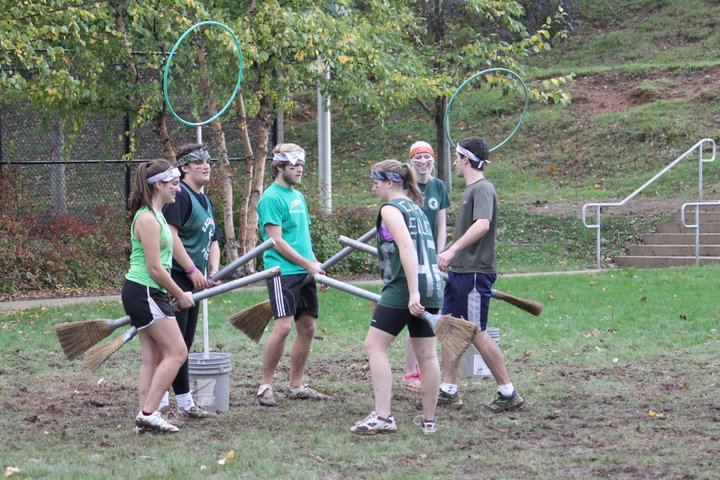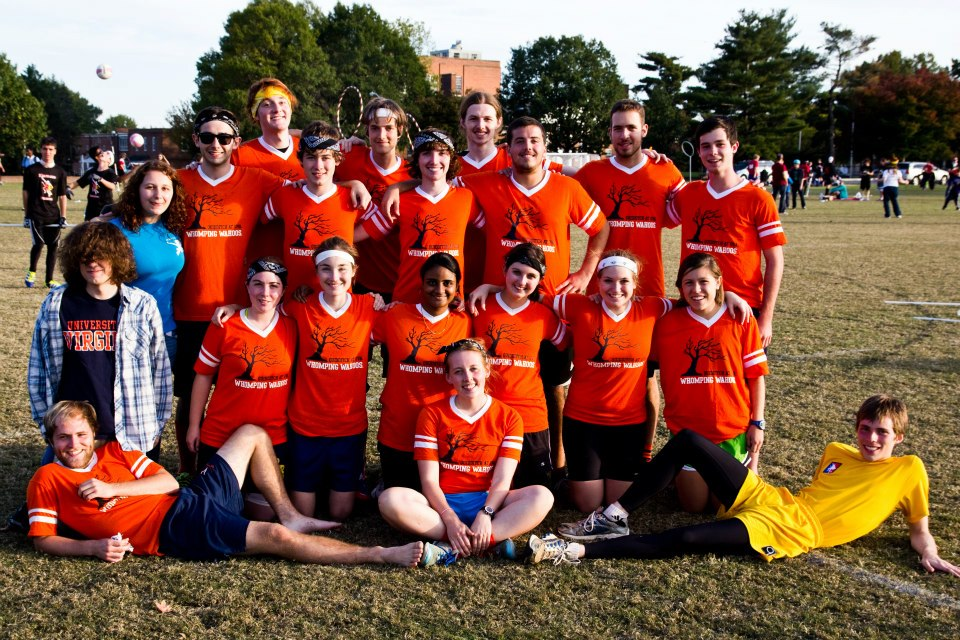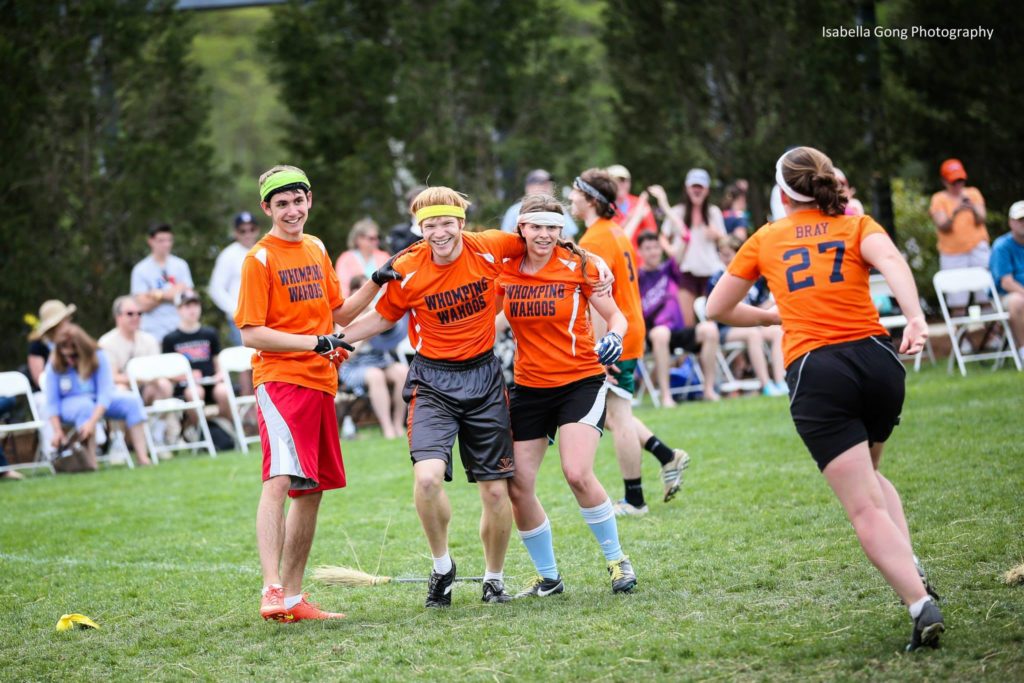Antwerp QC, Much of Belgian Core, Leaves Competitive Quidditch
By Erik Morlock and Anna Leonard
Guest Writers
This article is part of the “History of…” series curated by The Eighth Man and US Quidditch. The series highlights the individual histories of teams that qualified for US Quidditch Cup 10 to help both players and spectators get to know the story behind the teams. Head over to this link to read more.
The University of Virginia’s quidditch team has seen ups and downs: exciting upsets, unexpected losses and leadership turnover. However, throughout its six-year history, the team has had one constant—perseverance. The passion of its players and the dedication of the leadership lifted up this small team of kids, who found themselves on a makeshift quidditch pitch one Saturday afternoon in 2011, into a team that has consistently qualified for nationals and can be counted upon to succeed even in the face of doubt.
Quidditch at Virginia was founded by Travis Taylor in the fall semester of 2011. Taylor first played the sport in high school in Newport News, Va. and wanted to bring the sport to his university. The club was originally structured as an intramural league in which the houses were determined by student dorm and the hoops were lodged in buckets of concrete. Players from each “house” were selected by Taylor to compete as Virginia’s first competitive quidditch team. Those players included Kyle Stolcenberg (captain from 2011-15), Catherine Quinn and Anna Leonard, all of whom played through their senior years. Virginia joined the Virginia Quidditch League, competing against schools such as University of Richmond, College of William and Mary, and Virginia Tech. The team quickly learned the rules, and a freshly instituted executive board was committed to growing the team and jumping out of their state and onto the regional field the following year.
In the fall of 2012, the founders of the quidditch at Virginia recruited their first class of newcomers, which added Devon “Pajama Pants” Rea, Brian Stanley and Erik Morlock to the roster. Virginia’s consistent ability to utilize club fairs and an open “exposition” match to recruit has been a lasting strength of the team and has aided in keeping the overall quality of players high year after year. It was during this season the intramural component of the team was dropped, and the remaining team became the Whomping Wahoos—with Wahoo being the unofficial mascot of their university. Virginia was put in a challenging pool in their first appearance at the Mid-Atlantic Regional Championship stage, alongside Villanova University and Penn State University. Virginia lost both games but still sat in a promising position for a World Cup VI bid. In a best two-out-of-three series, Virginia was matched up against in-state rival University of Richmond for the bid. After three games and an off-pitch snitch catch in game three, it was Richmond who walked away with the bid. For the remainder of the season, Virginia maintained their momentum due to the strength and passion of the leadership, particularly captain Stolcenberg, and ended the 2012-13 season with several wins against World Cup-qualified teams.
Virginia continued to successfully recruit strong athletes in the 2013-14 season, including Chloe Downs, Bradley Hudson, Alex Zammitti, Brett Curtis and Jon Cohen—a McGill University alumnus. In fact, this recruiting season was so successful, Virginia created a B-team, which would become known as Jefferson’s Army after Thomas Jefferson, the founder of their school. Jefferson’s Army still competes unofficially—a testament to the dedication of Virginia players of both the A- and B-teams.
That year marked the infamous “Mid-Arctic” Regional Championship, where Virginia would fall in their World Cup-qualifying games, despite holding leads in both matches. UNC and the Appalachian Apparators snuck away with bids in games with the wind chill well below zero, and Virginia defeated Duke University to be the first regional alternate. Aided by some European turmoil in the form of six of the continent’s teams dropping, the University of Virginia would attend World Cup VII as an alternate bid. On day one at Virginia’s first national championship, the team saw a bittersweet ending. An unforgettable game against Bowling Green State University saw Virginia shocking the pot one Bowling Green with a catch while down 20. However, the win was not set in stone. Bowling Green protested the result, claiming that the snitch handicapped too early. USQ upheld the protest and the game was replayed, beginning at brooms up, with the score as it previously stood. Virginia lost bludger control, possession of the quaffle and, eventually, the match. However, an earlier upset against Hofstra University and a win against UC Berkeley proved enough, and Virginia moved on to see Day Two, where it would be dismantled by a Central Michigan University squad led by Ashley Calhoun. Nonetheless, the Virginia team maintained its reputation as a tough, scrappy team, making it farther than expected as an alternate bid.
The 2014-15 season began with a refresh for the team. The team was granted status as a full club-sport, prioritizing its funding and giving the team much-needed field space—along with a rebrand with new, crisp orange and white jerseys. The squad would also now officially be known as the Virginia Quidditch Club. Nonetheless, Virginia played yet another frustrating regional. After handily defeating George Mason University on Day One, George Mason, under the leadership of Ben Mertens, would come back fiercely when they faced off for a bid on Day Two. George Mason controlled the game with a slow-ball strategy designed to break down Virginia’s slow, methodical offense by limiting offensive possessions and drastically reducing pace of play. But Virginia made most of its second chance for a bid, defeating the Philadelphia Honey Badgers and Lock Haven University in the double-elimination bracket. This was an emotional victory for Virginia, as this was the senior year of its remaining founders.
The spring would bring the addition of some new talent to the women’s chaser line with Brittany Huffman moving up from Jefferson’s Army. World Cup 8 brought the Swiss-style tournament to quidditch, which did not favor a Virginia team that looked to study and outwit opponents rather than outmatch physically. First came a strong win against an upward trending Texas Tech University, Virginia’s first ever match against a Southwest team. Game two was against Northeast Regional Champion Tufts University, where Virginia suffered a three-digit loss. Following that match, Virginia was matched against Tufts’ neighbor, Harvard University. Virginia quickly found themselves in a 40-point hole and switched to a dual-male beater pair, featuring Stanley and Rea, and miraculously climbed out and came away with the win. With their eye on a 3-1 finish, next up was Blue Mountain Quidditch. However, that finish would quickly evaporate from the realm of possibility.
Despite a 20-point lead, Blue Mountain’s Calhoun would once again rain on the Virginia parade and lead the community team to victory. Virginia’s 2-2 day would prove to be enough and an elated Virginia made it to day two, yet again outperforming expectations of a team that received their bid through the loser’s bracket.
Day two kicked off with a familiar foe: Tufts. Despite that 100-point defeat on day one, Stolcenberg revised the Virginia zone defense significantly for the first time in the team’s history, moving 6’ 4” first-year John Hogan behind the hoops to halt Tuft’s strategy of dunking from behind, a position that is usually filled by the smallest chaser in the lineup. Virginia’s quick-thinking and deft performance under pressure led to an incredible defeat of Tufts, 70*-40. Virginia thus advanced to the Sweet 16, the farthest the club had ever advanced at the national and well beyond any published expectations. Virginia’s next opponent was West Coast community goliath, the Lost Boys. The tough match lasted nearly 40 minutes, but Virginia held their own, with starting beaters Leonard and Stanley keeping the game close for the first half. The loss ended a remarkable run by Virginia and gave the founding members an incredible end to their final season.
The 2015-16 season started with questions. Stolcenberg,the president and captain of the Virginia squad, hadled the team to improve each season. Now, Morlock would have some big shoes to fill stepping into his role. As one might have guessed, the team’s regional trip would still not go exactly as planned. Admittedly, it may not have for USQ either, with pitches that contained substantial patches of sand and electric fences close to hard boundaries; the playing conditions were not ideal. An early loss to Rutgers University in pool play forced Virginia into a challenging match on day two for the bid: a qualification rematch from three years ago against Richmond. A snitch-range game that went Richmond’s way forced Virginia to play, yet again, through the loser’s bracket, with VCU and James Madison University standing between Virginia and their next trip to nationals.
The remaining games would be snitch-range matches, but Virginia would squeak its way to earning its third consecutive bid. Leading up to nationals, Virginia was able to get its first win against another rival, University of Maryland. At nationals, Virginia drew that year’s pool-of-death, which featured the under-ranked, fifth-potted Crimson Elite. Virginia suffered losses to the first- and second-potted Rochester United and University of Kansas, respectively, and would finally get revenge on Calhoun in a big win over Lake Effect Maelstrom. Virginia would also pull off the (non-)upset of Crimson Elite. But a, Kansas loss to Crimson Elite left the pool standings with Virginia ranked four out of five and therefore out of contention for day two. The squad would be the only 2-2 team to not advance, despite 1-3 UC Berkeley advancing in another pool. A disappointing end, but Virginia was not to be held down for long.
Virginia is currently under the leadership of Alex Zammitti, the team’s starting keeper. Its methodical defense stands strong despite perpetually having a team filled with smaller athletes. And it has added a new feature to its reputation: speed. Virginia has continued to pick up the pace and has drastically increased their average possessions per game. As a team that has typically succeeded in keeping games low-scoring, they often struggled to put points on the board. This new, high-paced Virginia is certainly a step forward offensively. The squad’s performance at the recent Mid-Atlantic Regional Championship has placed its streak of bad luck at regionals behind them. Despite a low seeding, they ended day one at regionals undefeated, with a snitch-range win over former Northeast community team The Warriors. However, The Warriors ended up getting the best of Virginia in the the quarterfinals match for the first chance of a bid. And though they would see the loser’s bracket—again—Virginia bounced back and won their bid in an out-of-range match against the new Richmond community team, the Richmond Ravens. Top players Matthew Cooper, Gates Young, Sarah Vanlandingham and Colin Sullivan look to hone their chaser game and continue to surprise at nationals.
Virginia continues to develop its young talent and maintain its tradition of strong leadership and a positive, encouraging team environment. The current president, Huffman, has grown into a confident leader and is already preparing the next generation of talent to lead the team. Willing to think outside the box and leverage the strengths of its players, Virginia will likely continue to improve and thrive into the future.
Archives by Month:
- May 2023
- April 2023
- April 2022
- January 2021
- October 2020
- September 2020
- July 2020
- May 2020
- April 2020
- March 2020
- February 2020
- January 2020
- December 2019
- November 2019
- October 2019
- August 2019
- April 2019
- March 2019
- February 2019
- January 2019
- November 2018
- October 2018
- September 2018
- August 2018
- July 2018
- June 2018
- April 2018
- March 2018
- February 2018
- January 2018
- November 2017
- October 2017
- July 2017
- June 2017
- May 2017
- April 2017
- March 2017
- February 2017
- January 2017
- December 2016
- November 2016
- October 2016
- September 2016
- August 2016
- July 2016
- June 2016
- May 2016
- April 2016
- March 2016
- February 2016
- January 2016
- December 2015
- November 2015
- October 2015
- September 2015
- August 2015
- July 2015
- June 2015
- May 2015
- April 2015
- March 2015
- February 2015
- January 2015
- December 2014
- November 2014
- October 2014
- September 2014
- August 2014
- July 2014
- May 2014
- April 2014
- March 2014
- February 2014
- January 2014
- November 2013
- October 2013
- September 2013
- August 2013
- July 2013
- June 2013
- May 2013
- April 2013
- March 2013
- February 2013
- January 2013
- December 2012
- November 2012
- October 2012
Archives by Subject:
- Categories
- Awards
- College/Community Split
- Column
- Community Teams
- Countdown to Columbia
- DIY
- Drills
- Elo Rankings
- Fantasy Fantasy Tournaments
- Game & Tournament Reports
- General
- History Of
- International
- IQA World Cup
- Major League Quidditch
- March Madness
- Matches of the Decade
- Monday Water Cooler
- News
- Positional Strategy
- Press Release
- Profiles
- Quidditch Australia
- Rankings Wrap-Up
- Referees
- Rock Hill Roll Call
- Rules and Policy
- Statistic
- Strategy
- Team Management
- Team USA
- The Pitch
- The Quidditch Lens
- Top 10 College
- Top 10 Community
- Top 20
- Uncategorized
- US Quarantine Cup
- US Quidditch Cup




